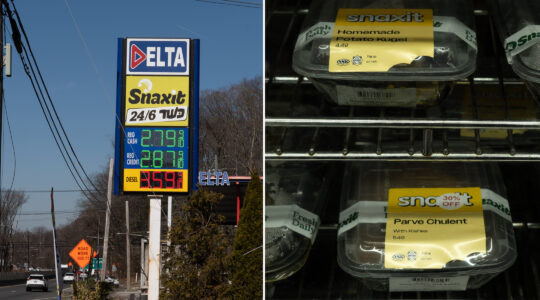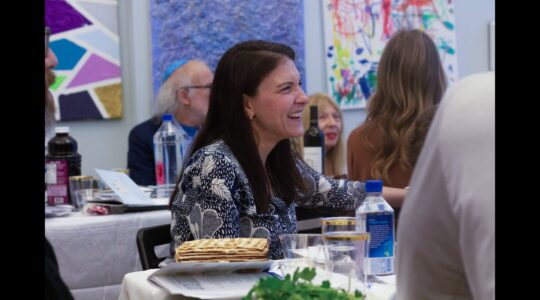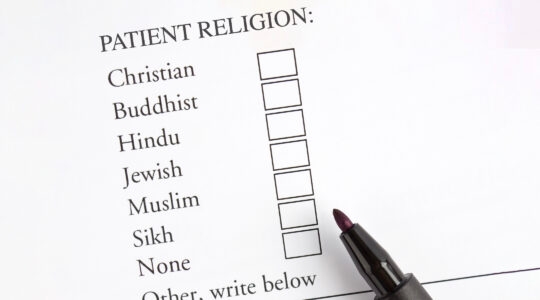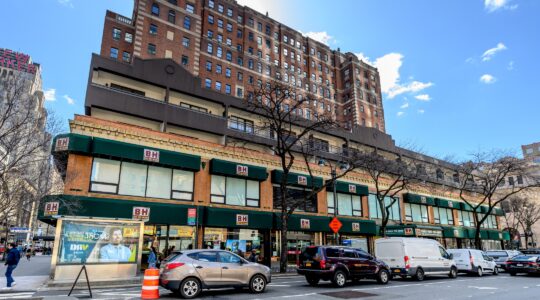Looking back, a member of the Venice Jewish community recalls being given cemetery plots as soon as she and her husband married several decades ago. Her husband told Israeli artist Hadassa Goldvicht, “We have already our place booked. Life is like that.”
Since 1982, Aldo Izzo has been the keeper, guardian and director of funeral ceremonies of Venice’s two Jewish cemeteries, the old one dating back to 1386 and the new, which still accepts burials, to 1774. He has buried 376 people and knows the assigned final resting places of the rest of Venice’s small Jewish community, now less than 500 people. They refer to a cemetery as Bed a Haim, or Beit Hayyim in Hebrew, the House of Life. It’s as though life and death exist at once, separated by the narrowest of corridors.
You can’t help but love and admire Izzo’s dedication, after seeing the exhibition of Goldvicht’s new work, “I Am Yours And My Dreams Are Yours/The House of Life” at Meislin Projects. The New York show offers a poetic glimpse of Goldvicht’s show “The House of Life,” on view at the Venice Biennale, at the Fondazione Querini Stampalia in Venice, presented in collaboration with the Israel Museum.
A viewer gets a sense of the sacred space of the cemetery upon entering the Meislin gallery, with a view shot from above by a drone; the cemetery appears as a mosaic of stone and green. The show includes video projections of interviews with the vibrant, humble and soulful Izzo, along with nine framed representations from the illustrated pages of the personal daily journal that he has kept since 1975. This summer, Izzo, a former sea captain, turns 87 as he continues to care for the dead, affirming life. The beauty of the show is in his collaged pages and his spirit, with his deep understanding of what endures.
The title of the show, “I Am Yours And My Dreams Are Yours,” is drawn from the Priestly Blessing ceremony, and Izzo draws the Hebrew letters of the verse on one page of his 1985 journal. Keeping a log was a habit from two decades at sea. Goldvicht photographed the open journals against a background of an ivory tablecloth — the entries feature Hebrew and English dates, details about his activities that day, people he saw and his interests. A colorful two-page spread from the 1980s for Rosh Hodesh, the new month, includes a striking drawing of the moon along with an explanation of the parsha, or Torah reading from that week, in Italian. Another page marks the day in 2000 that would have been his parents’ 100th anniversary. Elsewhere, he includes words that appear in mysterious characters, which turn out to be a secret language he shared with his brother.
“I do work that puts me at risk, definitely emotional risk; it’s always something connected to my life, and I do it with a lot of fear. I think that’s what makes us even.”
Goldvicht came to Venice in 2013, at the invitation of the Jewish community to create a project to mark the 500th year since the establishment of the Jewish Ghetto. She began interviewing residents, many of whom are elderly. When Goldvicht first met Izzo on a subsequent visit, she realized she had encountered a kindred spirit, and came to see how his life would speak for the community’s own balance of commitment to the past and uncertainties about its future. Her empathy is radiant.
“I never know what a new work will be,” she says in a telephone interview from her Jerusalem home. “When I first came I was looking for the right questions to ask. I’m very interested in language — we all hide so much behind it, use so many words that don’t mean a lot.
She says that the conversations quickly touched on private matters. As she asked about the struggles of life in Venice, she put people at ease by always arriving at the conversation feeling as vulnerable as the people she spoke with — she was then a new mother with two young children. In all of her projects, she says, “I do work that puts me at risk, definitely emotional risk; it’s always something connected to my life, and I do it with a lot of fear. I think that’s what makes us even.”
In a video, Izzo also explains his collection of mummified fresh water sea turtles, and lifts them individually from his crowded bookshelves as he speaks. He didn’t want to throw them away when they died, so he and his son dried them out in the sun, giving them names like Pansy, Mary Beth and Marcantonia.
“They will be forever and ever,” he says.
In one video, Goldvicht asks, “Aldo, you’re not afraid of death?”
“No, not afraid of death. Not at all,” he responds.
Asked if the project affected her own views of death, Goldvicht tells The Jewish Week, “I think I’m really occupied with death. Doing this project didn’t make me less afraid. It’s not a fear of death. It’s a fear of life.” She admits that she’s not as comfortable or “accepting of cemeteries as Aldo is.”
“Aldo has a rare ability to contain life, to contain life in a very special way, without fear. He’s a captain everywhere he goes. He has this ability to go very close to the small details and also to see the big picture.”
Born in Venice, Izzo was hidden by Christian neighbors during World War II. Before the war, he and his brother would often play in the cemetery. Now, he spends his time continuing to oversee the care and restoration of the cemetery. He has righted many stones that have fallen over, tended the vegetation and hung broken fragments of ancient tombstones on a wall of the old cemetery; when needed, he performs funerals. Caring for the dead is among the most altruistic of acts, for it can never be repaid.
Izzo also gives tours, and gallery owner Andrea Meislin, who has visited, describes his style of showing others around as performative art. In between the two Jewish cemeteries is a Christian cemetery, all on the Lido. Photographs show boats passing by very closely.
Meislin, describing Goldvicht’s art, says, “Her medium is life.”
“This process of art-making and checking one’s self, knowing that everything we do in this world has a spiritual effect and an actual effect. I try to keep that sensibility. That’s how I live my life.”
Goldvicht’s work has been exhibited widely, at venues including The Israel Museum, The Jewish Museum in New York and the Tate Modern in London. She studied at the Rhode Island School of Design and the School of Visual Arts here. The daughter of filmmakers, Goldvicht, 35, comes from a distinguished chasidic and rabbinic family.
“What I do is very much connected to ritual,” she says. The artist, whose great-great-grandfather was a well-known scribe, and whose uncles and relatives carefully write the tiny Hebrew text for tefillin, feels connected to them and their work. “This process of art-making and checking one’s self, knowing that everything we do in this world has a spiritual effect and an actual effect. I try to keep that sensibility. That’s how I live my life,” she says.
“This project has not ended. It will not have an ending. I hope to have these people as my family members for many years,” she says, referring to Izzo and other members of the community she came to know so well.
The show is layered in memory, from Izzo’s collages, to the recorded interviews, to new memories created by Goldvicht. Several days after visiting the gallery, I still hear the voice of Izzo chanting the 23rd Psalm, in perfect Hebrew with an Italian accent.
The catalog, “Hadassa Goldvicht: The House of Life,” is a handsome small book with a linen cover that is green, the color of life.
“I Am Yours And My Dreams Are Yours/The House of Life” is on view through Aug. 11 at Meislin Projects, 819 Madison Ave., 4C, meislinprojects.com. “Hadassa Goldvicht: The House of Life” is available for $20 at Meislin Projects.
The New York Jewish Week brings you the stories behind the headlines, keeping you connected to Jewish life in New York. Help sustain the reporting you trust by donating today.




